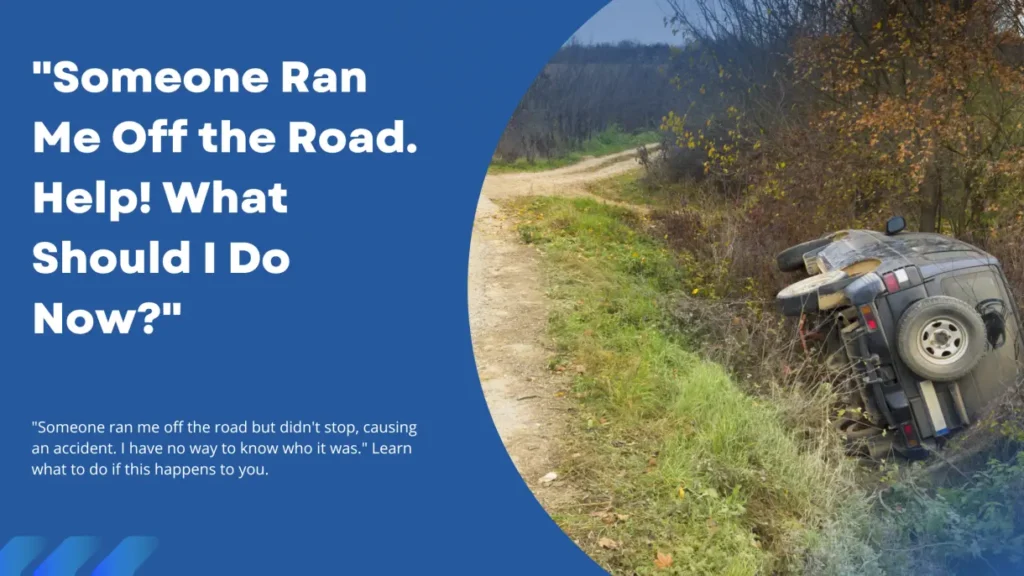Important: We updated this article in March 2025 after reviewing NHTSA accident and car insurance policy data in every state. Not every car crash happens when two vehicles collide. “No contact” accidents occur when another driver engages in reckless or negligent behavior that forces another driver to crash because of their actions — without ever touching them. We recently had a reader ask: “Another driver ran me off the road and didn’t stop. Now I have no way to find out who it was and am unsure of what to do. Any advice?” Yes: Get a free consultation with a car accident attorney right away.
This is known as a run-off-road (ROR) accident. and it’s more common than you might think. Accidents like this can be traumatizing for each victim, since they’re the only one that suffers. And the offending driver may not even realize what they’ve done, thus leaving the scene. This is especially true of semi-trucks that may not see a smaller car in their blind spot.
Ready to see if you may qualify? Click here to get a FREE, no-obligation consultation before starting your claim.
How Common Is It to Be Run Off the Road by Another Driver?
According to data from the National Motor Vehicle Crash Causation Survey (NMVCCS), ROR crashes account for 64.4% of single-vehicle crashes. And the National Highway Traffic Safety Administration found about 70% of all fatal single-vehicle crashes result from being run off the road.
Many ROR accidents kill drivers when the vehicle flips over or collides with a tree, pole, or barrier. Keep in mind, however, that not all ROR accidents stem from another driver’s actions. Other reasons may include things like:
- Distractions from other passengers
- Texting
- A wild animal running onto the road
- Ice, especially black ice in low light or nighttime driving conditions
And in those situations, the driver is at-fault for their own accident.
But in cases where the ROR is the result of another driver, that’s where it can get tricky. Especially if the other driver leaves the scene, which may be a crime, depending on the circumstances.
Frequently, the driver that caused an ROR accident may not even realize they were at fault. But clearly, it’s harder to settle a claim if you’re in a no-contact accident with an aptly named “phantom driver.”
Related: Driver Who Hit Me Gave Me False Information. What Now?
What Should I Do If Someone Ran Me Off the Road and I Wrecked My Car?
First, make certain you’re okay. Not all off-road situations are safe, so do not move from your vehicle unless you’re in harm’s way.
Then follow these steps:
1. Call 911 to contact police immediately.
We cannot stress enough how important it is to call police and report your accident, even if you fail to do so at the scene. Why? Because the other key piece of evidence (besides medical bills) is an official police report. Police officers can help with your investigation efforts by checking area video footage from nearby businesses, for example.
It’s also the best way to ensure your insurance policy pays for vehicle repairs if you cannot locate the other driver. Without the right documents to support your story about what happened, the insurance company might deny your claim.
You also want emergency response teams and police on the scene as soon as possible if you have any injuries. Even if you think your injuries or damages are minor, it’s important to call police and file an official report.
Important: If you know that you are injured, be sure seek medical care at the scene before you leave, if possible. You may not think or realize you need medical attention, but this provides key evidence for ensuring you receive a fair settlement.
2. Try to remember everything you can about the other vehicle that ran you off the road.
This includes things like:
- Color, make, license plate number (if possible)
- Any other identifying details you can remember about the responsible driver or their vehicle (i.e., beard, glasses, visible tattoos, bumper stickers, etc.)
3. Write down all the details you can remember about what happened right before and after the other driver ran you off the road.
Write down (or record in your phone) the date, time, and location where you were run off the road. Also include what happened leading up to it. For example, did the other car cut you off and drive you into a ditch? Or did the other motorist get distracted and drift into your lane, forcing you to swerve?
Maybe you noticed the other party texting or talking on the phone right before that. If you act quickly and make a record of it now, these details can be extremely helpful for supporting your accident claim.
4. Take photos of the whole car accident scene.
Try to get photos of any injuries you have at the accident scene as well as your own vehicle damage.
Pay attention to other things you notice that may prove vital for your injury claim, like:
- Is there a red light camera nearby? If so, a personal injury attorney may be able to request video surveillance footage of your accident.
- Are there black marks on guard rails or other signs of car damage patterns at the crash site?
- Did poor visibility or bad weather conditions potentially play a role in your being run off the road?
- Anything else that seems unusual, like a stop light not working properly, wild animal in the road, or a missing traffic sign?
5. Talk to any witnesses who saw your crash happen.
This part is crucial, especially if the responsible driver leaves the scene after you’re run off the road. Be sure to gather contact info for any bystanders who saw the accident happen. Ask them what they saw and how they think the accident occurred.
Eyewitness testimony can help prove your personal injury claim if you need to take legal action. It’s also important for proving to your insurance agent that you are not at fault.
6. Seek medical treatment at the scene or as soon as possible afterwards, even if you think you don’t need it.
Many people do not notice or feel soft-tissue injuries for several hours or even days after a car accident. But medical expenses are a key piece of evidence when seeking compensation to cover things like:
- Vehicle damage repair costs
- Rental car fees
- Lost wages
- Additional money for pain and suffering, which can significant increase your settlement amount
7. Contact a car accident lawyer for help holding the at-fault driver accountable for your accident.
It may be quite difficult to find the responsible driver without getting an attorney involved. Even with an official police report, there’s no guarantee they will be able to find the other driver. However, a good car accident lawyer can help you explore all your legal options and protect your rights.
How Your Car Insurance Company Will Likely Handle A Run Off the Road Accident
If you can somehow find the driver who ran you off the road, then you can claim damages. However, it won’t be easy if they refuse to admit fault. You will have to prove negligence through evidence from eyewitnesses, video footage, police reports, etc.
You May Have to File a Claim on Your Own Insurance Coverage
However, if another driver caused your accident and no one can find that person, you may have to file on your own insurance policy. Typically, your insurance will treat such a claim as they would an uninsured driver. This should count as an “uninsured motorist claim.” But don’t expect them to just hand you enough money to cover all the damages you now face.
The problem is that it can be hard to prove another driver caused your accident. Your insurance company may try to pay less than you deserve without enough “proof” about your version of events. This is mostly to keep people from falsely claiming “Oh, someone ran me off the road” when they actually are at fault for the accident.
What often happens in these cases, however, is that your insurance company will lowball your settlement offer. Or they’ll force you to file a claim stating you were at-fault to get any payout — even if that isn’t true.
And in some states, it doesn’t really matter who is at fault; you may have to file on your own policy anyway. Learn the difference between car accidents that happen in an at-fault vs. no-fault state.
How to Get a Free Consultation from a Car Accident Attorney if You’re Run Off the Road
This is one type of accident where you really need a lawyer, particularly if you have medical bills. Since you must provide all proof, it can be challenging even with uninsured motorist coverage. A skilled auto accident attorney is your best chance to get the settlement amount you deserve.
ROR cases are tricky, but not impossible to win. Don’t let your insurance company try to “ghost” you like the phantom driver did! Connect with a nearby lawyer for a free case review to learn how much your claim is actually worth.
Ready to see if you may qualify? Click here to get a FREE, no-obligation consultation before starting your claim.

